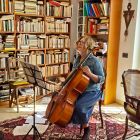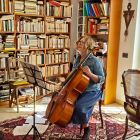Quartaccio: A Rome suburb.
Most Romans have never even heard of an area of the city called Quartaccio, yet it is a dazzling little pocket-mirror of the problems facing nearly all the less well-off areas on the outskirts of Rome. It is also an example of what is being done in the city to prevent them from sliding down the dangerous slope of the depressed suburbs of Paris.
Quartaccio, in fact, is above all a symbol of the isolation felt by many living on the outskirts, so much so that even finding the place is a puzzle that would fox an Einstein. Finally winkled out, it surprisingly turned out to overlook a green and windy valley otherwise masked from view by a flabbergasting jungle of wildly unregulated housing. It was south of Primavalle on Via Boccea in west Rome, just inside the Grande Raccordo Anulare.
As you see, its almost an English kind of settlement, remarked Mario Spada from the Assessorato alle Politiche per le Periferie, lo Sviluppo, il Lavoro (the city councils suburban development department), which has just opened in Quartaccio the third of its on-the-spot so-called social workshops, meant to spearhead the recovery of areas from long nightmares of social hardship. By English he meant that the people of Quartaccio lived not in Italian-style tenement buildings but in more homely two- or four-storey blocks not semis, though, but long, low, yellow-painted military-style cantonments reminiscent of old Singapore or Kuala Lumpur. But like other places in Rome, Laurentina 38 for instance, people are at present still isolated even from each other by real social barriers.
We were outside a converted farmhouse, the site of the new workshop. Around here the flats were mainly built by cooperatives so people are better off than they are on the other side of the road there, Via Andersen, the local frontier, where you have only council housing put up between 1975 and 1980. Thats called Quartaccio 2; this is Quartaccio 1. Our first challenge is to break down the frontier, get rid of 1 and 2, get people meeting each other, communicating. Youll see the difference between the two worlds.
We did. Whereas 1 was all neat and clean, 2 was all shabby and eerily quiet. Only now were once overgrown plots of wasteland being attractively re-paved; but roofs apparently still leaked, rubbish was all over the place and cannibalised old motorini lay inside boarded-up shop fronts. We were now moving through a completely abandoned intended shopping centre. Because of demands for protection money by criminal gangs around here it never got off the ground, explained Spada. The absence of shops means nobody comes here. Thats one reason why theres no money around; so, as you see, there are plenty of parking places, often occupied by stolen cars about to be sold.
A social worker, Manuela Solidomi, was with us. Delinquency, yes, but theres no bag-snatching here! And there are no drug-pushers either. Why? Because theres nowhere for young people to congregate. Solidomi had lived in Quartaccio for 17 years so she knew her stuff.
Spada said in one way Quartaccio was like Corviale, the kilometre-long housing monster near the coast that today cuts off Rome from its once precious sea breeze, the Ponentino. With some 2,000 people here its smaller but, as in Corviale, squatters took over many of the flats, most of them migrants from Sicily, which of course intensifies the frontier problem. The main scourges here are unemployment and poverty. We also have a lot of single mothers. The squatter situation, though, has gone away because the city has them pay only a rent they can afford. You mean less than 100 a month? Often much less.
So what is being done about it all otherwise? Spada and Solidomi replied that the key was to get local residents involved in things. Quartaccio already had a local news sheet, which reported in its latest issue: Theres anger here, fear and a loss of hope but, on the other hand, a real will to do something about it. And Solidomi ran one of two council-funded groups of animatori (coordinators of socio-cultural activities), the Associazione Gruppo di Iniziativa Sociale Marameo (Cock-a-Snook Social Initiative Association) and Vivere in Quartaccio (Living in Quartaccio), which are both linked in turn to city council-aided organisations in other parts of Rome. They were teaching people how to set up small money-making cooperatives to undertake local street-cleaning, for instance. They were also laying on regular meetings and chat-points to enable the comune and residents to throw out bridges to each other, so that grievances and the many hardship cases could be listened to, listed and acted upon.
The council was above all setting up in Quartaccio a help centre for the citys many victims of loan-sharks, which would cater for much of the capital. Housed in the old farmhouse, it would counsel victims who have so far not dared report the sharks and to enable those who have done so to struggle back to normal life. On tap would be psychiatrists, lawyers, financial advisers and bank officials, already staffing similar help centres in Ostia, Centocelle and Cinecitt.
Were already getting some social cohesion in Quartaccio. Thats positive, concluded Spada.





















